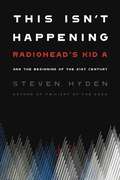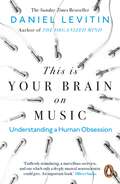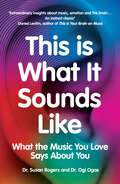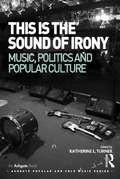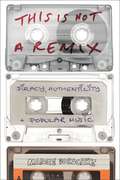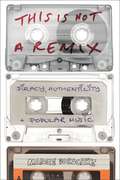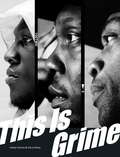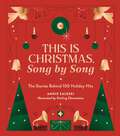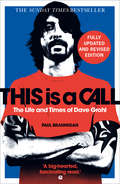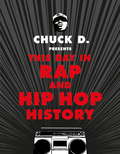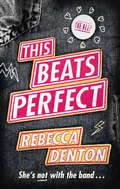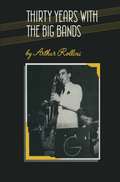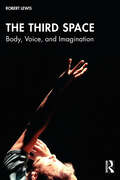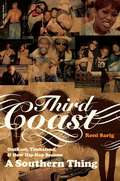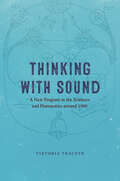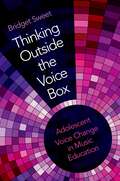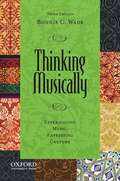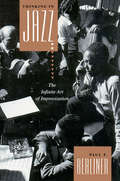- Table View
- List View
This Isn't Happening: Radiohead's "Kid A" and the Beginning of the 21st Century
by Steven HydenThe making and meaning of Radiohead's groundbreaking, controversial, epoch-defining album, Kid A.In 1999, as the end of an old century loomed, five musicians entered a recording studio in Paris without a deadline. Their band was widely recognized as the best and most forward-thinking in rock, a rarefied status granting them the time, money, and space to make a masterpiece. But Radiohead didn't want to make another rock record. Instead, they set out to create the future.For more than a year, they battled writer's block, inter-band disagreements, and crippling self-doubt. In the end, however, they produced an album that was not only a complete departure from their prior guitar-based rock sound, it was the sound of a new era, and embodied widespread changes catalyzed by emerging technologies just beginning to take hold of the culture.What they created was Kid A. At the time, Radiohead's fourth album divided critics. Some called it an instant classic; others, including the U.K. music magazine Melody Maker, deemed it "tubby, ostentatious, self-congratulatory . . . whiny old rubbish." But two decades later, Kid A sounds like nothing less than an overture for the chaos and confusion of the twenty-first century.Acclaimed rock critic Steven Hyden digs deep into the songs, history, legacy, and mystique of Kid A, outlining the album's pervasive influence and impact on culture, in time for its 20th anniversary. Deploying a mix of criticism, journalism, and personal memoir, Hyden skillfully revisits this enigmatic, alluring LP and investigates the many ways in which Kid A shaped and foreshadowed our world.
This is Your Brain on Music: Understanding a Human Obsession
by Daniel LevitinThis is the first book to offer a comprehensive explanation of how humans experience music and to unravel the mystery of our perennial love affair with it. Using musical examples from Bach to the Beatles, Levitin reveals the role of music in human evolution, shows how our musical preferences begin to form even before we are born and explains why music can offer such an emotional experience.Music is an obsession at the heart of human nature, even more fundamental to our species than language. In This Is Your Brain On Music Levitin offers nothing less than a new way to understand it, and its role in human life
This Is What It Sounds Like: What the Music You Love Says About You
by Dr. Susan Rogers Ogi OgasLegendary record producer-turned-brain scientist explains why you fall in love with music.'Extraordinary insights about music, emotion and the brain...An instant classic' Daniel Levitin, author of This Is Your Brain on MusicThis Is What It Sounds Like is a journey into the science and soul of music. It's also the story of a musical trailblazer who began as a humble audio tech in L.A. to become Prince's chief engineer for Purple Rain and one of the most successful female record producers of all time.Now an award-winning professor of cognitive neuroscience, Dr Susan Rogers takes readers behind the scenes of record-making and leads us to musical self-awareness. She explains that everyone possesses a unique 'listener profile', shows how being musical can mean actively listening, and encourages us to think about the records that define us. Lively and illuminating, this book will refresh your playlists, deepen your connection to artists, and change the way you listen to music.'Superb... this book can show you how to be a better listener' Times Literary Supplement 'A provocative blend of studio stories and fascinating neuroscience' Alan Light, author of Let's Go Crazy: Prince and the Making of Purple Rain'Fizzing with energy and insight...a crucial addition to the canon of music must-reads' Kate Hutchinson
This is the Sound of Irony: Music, Politics And Popular Culture (Ashgate Popular and Folk Music Series)
by Katherine L. TurnerThe use of irony in music is just beginning to be defined and critiqued, although it has been used, implied and decried by composers, performers, listeners and critics for centuries. Irony in popular music is especially worthy of study because it is pervasive, even fundamental to the music, the business of making music and the politics of messaging. Contributors to this collection address a variety of musical ironies found in the ’notes themselves,’ in the text or subtext, and through performance, reception and criticism. The chapters explore the linkages between irony and the comic, the tragic, the remembered, the forgotten, the co-opted, and the resistant. From the nineteenth to twenty-first centuries, through America, Europe and Asia, this provocative range of ironies course through issues of race, religion, class, the political left and right, country, punk, hip hop, folk, rock, easy listening, opera and the technologies that make possible our pop music experience. This interdisciplinary volume creates new methodologies and applies existing theories of irony to musical works that have made a cultural or political impact through the use of this most multifaceted of devices.
This is the Sound of Irony: Music, Politics And Popular Culture (Ashgate Popular and Folk Music Series)
by Katherine L. TurnerThe use of irony in music is just beginning to be defined and critiqued, although it has been used, implied and decried by composers, performers, listeners and critics for centuries. Irony in popular music is especially worthy of study because it is pervasive, even fundamental to the music, the business of making music and the politics of messaging. Contributors to this collection address a variety of musical ironies found in the ’notes themselves,’ in the text or subtext, and through performance, reception and criticism. The chapters explore the linkages between irony and the comic, the tragic, the remembered, the forgotten, the co-opted, and the resistant. From the nineteenth to twenty-first centuries, through America, Europe and Asia, this provocative range of ironies course through issues of race, religion, class, the political left and right, country, punk, hip hop, folk, rock, easy listening, opera and the technologies that make possible our pop music experience. This interdisciplinary volume creates new methodologies and applies existing theories of irony to musical works that have made a cultural or political impact through the use of this most multifaceted of devices.
This is Not a Remix: Piracy, Authenticity and Popular Music
by Margie BorschkeWidespread distribution of recorded music via digital networks affects more than just business models and marketing strategies; it also alters the way we understand recordings, scenes and histories of popular music culture. This Is Not a Remix uncovers the analog roots of digital practices and brings the long history of copies and piracy into contact with contemporary controversies about the reproduction, use and circulation of recordings on the internet.Borschke examines the innovations that have sprung from the use of recording formats in grassroots music scenes, from the vinyl, tape and acetate that early disco DJs used to create remixes to the mp3 blogs and vinyl revivalists of the 21st century. This is Not A Remix challenges claims that 'remix culture' is a substantially new set of innovations and highlights the continuities and contradictions of the Internet era. Through an historical focus on copy as a property and practice, This Is Not a Remix focuses on questions about the materiality of media, its use and the aesthetic dimensions of reproduction and circulation in digital networks. Through a close look at sometimes illicit forms of composition-including remixes, edits, mashup, bootlegs and playlists-Borschke ponders how and why ideals of authenticity persist in networked cultures where copies and copying are ubiquitous and seemingly at odds with romantic constructions of authorship. By teasing out unspoken assumptions about media and culture, this book offers fresh perspectives on the cultural politics of intellectual property in the digital era and poses questions about the promises, possibilities and challenges of network visibility and mobility.
This is Not a Remix: Piracy, Authenticity and Popular Music
by Margie BorschkeWidespread distribution of recorded music via digital networks affects more than just business models and marketing strategies; it also alters the way we understand recordings, scenes and histories of popular music culture. This Is Not a Remix uncovers the analog roots of digital practices and brings the long history of copies and piracy into contact with contemporary controversies about the reproduction, use and circulation of recordings on the internet.Borschke examines the innovations that have sprung from the use of recording formats in grassroots music scenes, from the vinyl, tape and acetate that early disco DJs used to create remixes to the mp3 blogs and vinyl revivalists of the 21st century. This is Not A Remix challenges claims that 'remix culture' is a substantially new set of innovations and highlights the continuities and contradictions of the Internet era. Through an historical focus on copy as a property and practice, This Is Not a Remix focuses on questions about the materiality of media, its use and the aesthetic dimensions of reproduction and circulation in digital networks. Through a close look at sometimes illicit forms of composition-including remixes, edits, mashup, bootlegs and playlists-Borschke ponders how and why ideals of authenticity persist in networked cultures where copies and copying are ubiquitous and seemingly at odds with romantic constructions of authorship. By teasing out unspoken assumptions about media and culture, this book offers fresh perspectives on the cultural politics of intellectual property in the digital era and poses questions about the promises, possibilities and challenges of network visibility and mobility.
This Is Grime
by Hattie Collins Olivia Rose'In British music, you have indie, rock... Grime is now one of those pillars. It's a foundation of British music.' - StormzyShortlisted for the Penderyn Music Book Prize 201713 years ago, from the depths of Bow E3, the voice of a generation emerged.It was dark, it was angry, it was loud, it was unapologetic. It was provocative and fiercely independent.It was the brittle sound of disillusionment, resentment and despair, but also the voice of hope...This Is Grime.Written by Hattie Collins (i-D, the Guardian, The Sunday Times), an authority on Grime who has documented the scene since its beginnings, and accompanied by beautiful images shot by award-winning photographer Olivia Rose solely for the book, THIS IS GRIME will have unrivaled access to the artists and influencers who have created and cultivated the culture over the past fifteen years. Telling their stories and the story of this musical culture - one of the most significant working class British subcultures of its time - in tandem.
This Is Christmas, Song by Song: The Stories Behind 100 Holiday Hits
by Annie ZaleskiCelebrate the merriest season of the year with award-winning author and music journalist Annie Zaleski's collection of the 100 most popular and beloved holiday songs of all time. 'Tis the season! Break out the eggnog, hang the mistletoe, blast those Christmas songs, and settle down in your favorite armchair with this beautifully illustrated volume exploring well-known and lesser-known behind-the-scenes stories of the 100 most cherished holiday songs of all time and their everlasting impact. From artists such as Bing Crosby and Ella Fitzgerald all the way up to Mariah Carey and Ariana Grande, this all-encompassing collection of holiday favorites (called one of "the 25 best Christmas books of all time" by Book Riot) is sure to warm your heart during the merriest season of the year. What song was listed in the Guinness Book of World Records as the best-selling single of all time? Which popular Christmas tune was reportedly written to commemorate Thanksgiving? What holiday song led to a special meet-and-greet between the song's 10-year-old singer and a 700-pound hippopotamus? Spanning musical genres and decades of classics and modern hits, some of the featured songs include: &“White Christmas&” by Bing Crosby "All I Want for Christmas Is You" by Mariah Carey "Deck the Halls" by Mannheim Steamroller &“Christmas Tree Farm&” by Taylor Swift &“Christmas Time (Is Here Again)" by The Beatles &“Feliz Navidad&” by José Feliciano "Rudolph the Red-Nosed Reindeer" by Gene Autry "You Make It Feel Like Christmas" by Gwen Stefani &“Santa Baby&” by Eartha Kitt &“Rockin&’ around the Christmas Tree&” by Brenda Lee &“Merry Christmas, Happy Holidays&” by NSYNC &“Run Rudolph Run&” by Chuck Berry And many more! Including full-color illustrations throughout, this gorgeously packaged compendium is the perfect gift for you and your loved ones to experience the holiday magic year after year.
This Is a Call: The Life And Times Of Dave Grohl
by Paul Brannigan‘Someone called and said Kurt died. I just f*****g lost it.’
This Day in Rap and Hip-Hop History
by Chuck DForeword by Shepard Fairey.As featured in Best stocking-filler books of 2017 - The GuardianIf you want to understand our culture. To learn knowledge itself. Truth about the art form of poetry in motion. The struggle of our community through rhyme and rhythm. This is the book that inspired me long before I found my place in hip-hop. The power of self-expression. Unapologetically. Taught by the teacher himself. Chuck D!!!Kendrick LamarThis book is required reading for those who claim to know hip-hop, love hip-hop, and want their information from a true Master and General of the hip-hop culture...Public Enemy #1, Chuck D!Ice-TChuck D wasn't put here to play any games. He created the greatest hip-hop album in my opinion to date, It Takes a Nation of Millions to Hold Us Back. But the very first minute he sonically appeared to us, I knew rap was changed forever. Power, awareness, strength, and militancy is his stance in a world obsessed with punishing poor people. I knew he would righteously and boldly die so that a little young boy he didn't even know from Queensbridge could live. He attacked wickedness head-on being the rappin' rhino terror that he is. He represented for all of us putting his life on the line and making the right music fighting for hip hop, the youth, truth, and justice. Chuck D made the lane for people like me to walk.NasReading this book is like reliving my life all over again. Chuck D is Dope!!!LL Cool JIn the more than 40 years since the days of DJ Kool Herc and "Rapper's Delight," hip-hop and rap have become a billion-pound worldwide cultural phenomenon that reaches well beyond music, into fashion, movies, art and politics. Yet there is no definitive history of the genre - until now.This massive compendium details the most iconic moments and influential songs in the genre's recorded history, from Kurtis Blow's "Christmas Rappin'" to The Miseducation of Lauryn Hill to Kendrick Lamar's verse on "Control." Also included are key events in hip-hop history, from Grandmaster Flash's first scratch through to Tupac's holographicappearance at Coachella.Throughout the book, Chuck offers an insider's perspective on the chart toppers, artists and key moments. Illustrating the pages are more than 150 portraits from mADurgency, an artist collective specialising in art and design for the hip-hop community.
This Beats Perfect (This Beats Perfect #2)
by Rebecca Denton'This Beats Perfect is a fabulous celebration of music, friendship, and following your dreams' Katherine Webber, author of Wing JonesAmelie Ayres has impeccable taste in music. Bowie. Bush. Bob. So when she finds herself backstage at The Keep's only UK gig she expects to hate it; after all they are the world's most tragic band. In fact she feels a grudging respect - not (obviously) for their music, but for the work that goes in to making them megastars. And when lead singer, 'Maxx', is not dressed up as a cross between Elvis and a My Little Pony, he is actually rather normal, talented and has creative struggles not too dissimilar to her own. But the next morning she wakes up and rolls over to discover a million new @'s on social media. Overnight, a photo of her at the gig has made her a subject of global speculation. Suddenly the world needs to know #Who'sThatGirl? - but for all the wrong reasons.All Amelie wants is to play her music. She's got the guitar, the songs, the soul and, in the safety of her bedroom, she's got the voice. But when it comes to getting up on stage, she struggles with self-doubt.Immaculate's a concept. Flawless is fake. But just sometimes music - and hearts - can rock a perfect beat.'A witty exploration into the world of celebrity' The Sun
Thirty Years with the Big Bands
by Arthur RolliniArthur Rollini describes his career as a tenor saxophonist in the big US jazz orchestras. In the 1920s he played in London with the Savoy Dance Orchestra and on his return to the USA he joined the nascent Benny Goodman Orchestra, before working in the bands of the Dorsey Brothers, Paul Whiteman and Ray McKinley. He thus tells an insider's story of the foremost white swing orchestras. Rollini's account of the early development of jazz in England and Europe and of the growth of the Goodman Orchestra will be of great use to jazz historians, as will his discussion of his brother Adrian's career. The book contains a number of rare photographs.
The Third Space: Body, Voice, and Imagination
by Robert LewisThe Third Space serves a crucial need for contemporary performers by providing an interdisciplinary and physiovocal approach to training. It is a new take on body and voice integration designed to develop the holistic performer. It takes performers through a series of step-by-step practical physiovocal exercises that connects the actor’s centre to the outside world, which increases awareness of self and space. It also develops a deeper connection between spaces within the body and the environment by connecting sound, imagination, and movement.Robert Lewis’s approach is a way of working that unlocks the imagination as well as connecting performers to self, space, and imagination, through voice and body. It conditions, controls, and engages performers by integrating various voice and movement practices.The theories and practice are balanced throughout by: introducing the practical works theoretical underpinnings through research, related work, and case studies of performances; demonstrating a full program of exercises that helps performers get in touch with their centre, their space, and shape both within and outside the body; and exploring the performers physiovocal instrument and its connection with imagination, energies, and dynamics. This book is the result of nearly 20 years of research and practice working with voice and movement practitioners across the globe to develop training that produces performers that are physiovocally ready to work in theatre, screen, and emergent technologies.
The Third Space: Body, Voice, and Imagination
by Robert LewisThe Third Space serves a crucial need for contemporary performers by providing an interdisciplinary and physiovocal approach to training. It is a new take on body and voice integration designed to develop the holistic performer. It takes performers through a series of step-by-step practical physiovocal exercises that connects the actor’s centre to the outside world, which increases awareness of self and space. It also develops a deeper connection between spaces within the body and the environment by connecting sound, imagination, and movement.Robert Lewis’s approach is a way of working that unlocks the imagination as well as connecting performers to self, space, and imagination, through voice and body. It conditions, controls, and engages performers by integrating various voice and movement practices.The theories and practice are balanced throughout by: introducing the practical works theoretical underpinnings through research, related work, and case studies of performances; demonstrating a full program of exercises that helps performers get in touch with their centre, their space, and shape both within and outside the body; and exploring the performers physiovocal instrument and its connection with imagination, energies, and dynamics. This book is the result of nearly 20 years of research and practice working with voice and movement practitioners across the globe to develop training that produces performers that are physiovocally ready to work in theatre, screen, and emergent technologies.
Third Coast: Outkast, Timbaland, and How Hip-hop Became a Southern Thing
by Roni SarigTypically, more than half the top rap songs in the country are the work of Southern artists. In a world still stuck in the East/West coast paradigm of the '90s, Southern hip hop has dominated the genre-and defined the culture-for years. And the South's leading lights, most notably OutKast, Timbaland, and more recently, crunk superstars like the Ying Yang Twins and Lil Jon, have expanded the parameters of hip hop. Third Coast is the first book to deal with Southern hip hop as a matter of cultural history, and the first to explain the character and significance of down South rapping to fans as well as outsiders. It tells the story of recent hip hop, marking how far the music has come sonically and culturally since its well-documented New York-centered early years.
Thinking with Sound: A New Program in the Sciences and Humanities around 1900
by Viktoria TkaczykThinking with Sound traces the formation of auditory knowledge in the sciences and humanities in the decades around 1900. When the outside world is silent, all sorts of sounds often come to mind: inner voices, snippets of past conversations, imaginary debates, beloved and unloved melodies. What should we make of such sonic companions? Thinking with Sound investigates a period when these and other newly perceived aural phenomena prompted a far-reaching debate. Through case studies from Paris, Vienna, and Berlin, Viktoria Tkaczyk shows that the identification of the auditory cortex in late nineteenth-century neuroanatomy affected numerous academic disciplines across the sciences and humanities. “Thinking with sound” allowed scholars and scientists to bridge the gaps between theoretical and practical knowledge, and between academia and the social, aesthetic, and industrial domains. As new recording technologies prompted new scientific questions, new auditory knowledge found application in industry and the broad aesthetic realm. Through these conjunctions, Thinking with Sound offers a deeper understanding of today’s second “acoustic turn” in science and scholarship.
Thinking with Sound: A New Program in the Sciences and Humanities around 1900
by Viktoria TkaczykThinking with Sound traces the formation of auditory knowledge in the sciences and humanities in the decades around 1900. When the outside world is silent, all sorts of sounds often come to mind: inner voices, snippets of past conversations, imaginary debates, beloved and unloved melodies. What should we make of such sonic companions? Thinking with Sound investigates a period when these and other newly perceived aural phenomena prompted a far-reaching debate. Through case studies from Paris, Vienna, and Berlin, Viktoria Tkaczyk shows that the identification of the auditory cortex in late nineteenth-century neuroanatomy affected numerous academic disciplines across the sciences and humanities. “Thinking with sound” allowed scholars and scientists to bridge the gaps between theoretical and practical knowledge, and between academia and the social, aesthetic, and industrial domains. As new recording technologies prompted new scientific questions, new auditory knowledge found application in industry and the broad aesthetic realm. Through these conjunctions, Thinking with Sound offers a deeper understanding of today’s second “acoustic turn” in science and scholarship.
Thinking Outside the Voice Box: Adolescent Voice Change in Music Education
by Bridget SweetThe changing adolescent voice counts among the most awkward of topics voice teachers and choir directors face. Adolescent voice students already find themselves at a volatile developmental time in their lives, and the stresses and possible embarrassments of unpredictable vocal capabilities make participation in voice-based music an especially fraught event. In this practical teaching guide, author Bridget Sweet encourages a holistic approach to female and male adolescent voice change. Sweet's approach takes full consideration of the body, brain, and auditory system; vocal anatomy and physiology in general, as well as during male and female voice change; and the impact of hormones on the adolescent voice, especially for female singers. Beyond the physical, it also addresses the emotional and psychological components: ideas of resolve and perseverance that are essential to adolescent navigation of voice change; and exploration of portrayals and stereotypes in pop culture that influence how people anticipate voice change experiences for teens and 'tweens, from The Brady Bunch to The Wonder Years to The Simpsons. As a whole, Teaching Outside the Voice Box encourages music educators to more effectively and compassionately assist students through this developmental experience.
Thinking Outside the Voice Box: Adolescent Voice Change in Music Education
by Bridget SweetThe changing adolescent voice counts among the most awkward of topics voice teachers and choir directors face. Adolescent voice students already find themselves at a volatile developmental time in their lives, and the stresses and possible embarrassments of unpredictable vocal capabilities make participation in voice-based music an especially fraught event. In this practical teaching guide, author Bridget Sweet encourages a holistic approach to female and male adolescent voice change. Sweet's approach takes full consideration of the body, brain, and auditory system; vocal anatomy and physiology in general, as well as during male and female voice change; and the impact of hormones on the adolescent voice, especially for female singers. Beyond the physical, it also addresses the emotional and psychological components: ideas of resolve and perseverance that are essential to adolescent navigation of voice change; and exploration of portrayals and stereotypes in pop culture that influence how people anticipate voice change experiences for teens and 'tweens, from The Brady Bunch to The Wonder Years to The Simpsons. As a whole, Teaching Outside the Voice Box encourages music educators to more effectively and compassionately assist students through this developmental experience.
Thinking Musically: Experiencing Music, Expressing Culture (pdf) (Global Music Ser.)
by Bonnie C. WadeAs the cornerstone of the Global Music Series, Thinking Musically, Third Edition, explores musical diversity by integrating the sounds and traditions of world cultures. Bonnie C. Wade discusses how various cultural influences-gender, ethnicity, mass media, westernization, nationalism, and acculturation-are shaping music and the ways that we experience it. WHAT'S NEW TO THE THIRD EDITION? * Simplified and incorporates recent additions to the Global Music Series * New charts and diagrams delve into important musical concepts * Updated companion website includes a new guide to online and print resources, a sample syllabi, and teaching tips Visit www.oup.com/us/globalmusic for a list of case studies in the Global Music Series. The website also includes instructional material to accompany each study.
Thinking in Jazz: The Infinite Art of Improvisation (Chicago Studies in Ethnomusicology)
by Paul F. BerlinerA landmark in jazz studies, Thinking in Jazz reveals as never before how musicians, both individually and collectively, learn to improvise. Chronicling leading musicians from their first encounters with jazz to the development of a unique improvisatory voice, Paul Berliner documents the lifetime of preparation that lies behind the skilled improviser's every idea. The product of more than fifteen years of immersion in the jazz world, Thinking in Jazz combines participant observation with detailed musicological analysis, the author's experience as a jazz trumpeter, interpretations of published material by scholars and performers, and, above all, original data from interviews with more than fifty professional musicians: bassists George Duvivier and Rufus Reid; drummers Max Roach, Ronald Shannon Jackson, and Akira Tana; guitarist Emily Remler; pianists Tommy Flanagan and Barry Harris; saxophonists Lou Donaldson, Lee Konitz, and James Moody; trombonist Curtis Fuller; trumpeters Doc Cheatham, Art Farmer, Wynton Marsalis, and Red Rodney; vocalists Carmen Lundy and Vea Williams; and others. Together, the interviews provide insight into the production of jazz by great artists like Betty Carter, Miles Davis, Dizzy Gillespie, Coleman Hawkins, and Charlie Parker. Thinking in Jazz overflows with musical examples from the 1920s to the present, including original transcriptions (keyed to commercial recordings) of collective improvisations by Miles Davis's and John Coltrane's groups. These transcriptions provide additional insight into the structure and creativity of jazz improvisation and represent a remarkable resource for jazz musicians as well as students and educators. Berliner explores the alternative ways—aural, visual, kinetic, verbal, emotional, theoretical, associative—in which these performers conceptualize their music and describes the delicate interplay of soloist and ensemble in collective improvisation. Berliner's skillful integration of data concerning musical development, the rigorous practice and thought artists devote to jazz outside of performance, and the complexities of composing in the moment leads to a new understanding of jazz improvisation as a language, an aesthetic, and a tradition. This unprecedented journey to the heart of the jazz tradition will fascinate and enlighten musicians, musicologists, and jazz fans alike.
Thinking in Jazz: The Infinite Art of Improvisation (Chicago Studies in Ethnomusicology)
by Paul F. BerlinerA landmark in jazz studies, Thinking in Jazz reveals as never before how musicians, both individually and collectively, learn to improvise. Chronicling leading musicians from their first encounters with jazz to the development of a unique improvisatory voice, Paul Berliner documents the lifetime of preparation that lies behind the skilled improviser's every idea. The product of more than fifteen years of immersion in the jazz world, Thinking in Jazz combines participant observation with detailed musicological analysis, the author's experience as a jazz trumpeter, interpretations of published material by scholars and performers, and, above all, original data from interviews with more than fifty professional musicians: bassists George Duvivier and Rufus Reid; drummers Max Roach, Ronald Shannon Jackson, and Akira Tana; guitarist Emily Remler; pianists Tommy Flanagan and Barry Harris; saxophonists Lou Donaldson, Lee Konitz, and James Moody; trombonist Curtis Fuller; trumpeters Doc Cheatham, Art Farmer, Wynton Marsalis, and Red Rodney; vocalists Carmen Lundy and Vea Williams; and others. Together, the interviews provide insight into the production of jazz by great artists like Betty Carter, Miles Davis, Dizzy Gillespie, Coleman Hawkins, and Charlie Parker. Thinking in Jazz overflows with musical examples from the 1920s to the present, including original transcriptions (keyed to commercial recordings) of collective improvisations by Miles Davis's and John Coltrane's groups. These transcriptions provide additional insight into the structure and creativity of jazz improvisation and represent a remarkable resource for jazz musicians as well as students and educators. Berliner explores the alternative ways—aural, visual, kinetic, verbal, emotional, theoretical, associative—in which these performers conceptualize their music and describes the delicate interplay of soloist and ensemble in collective improvisation. Berliner's skillful integration of data concerning musical development, the rigorous practice and thought artists devote to jazz outside of performance, and the complexities of composing in the moment leads to a new understanding of jazz improvisation as a language, an aesthetic, and a tradition. This unprecedented journey to the heart of the jazz tradition will fascinate and enlighten musicians, musicologists, and jazz fans alike.
Thinking in Jazz: The Infinite Art of Improvisation (Chicago Studies in Ethnomusicology)
by Paul F. BerlinerA landmark in jazz studies, Thinking in Jazz reveals as never before how musicians, both individually and collectively, learn to improvise. Chronicling leading musicians from their first encounters with jazz to the development of a unique improvisatory voice, Paul Berliner documents the lifetime of preparation that lies behind the skilled improviser's every idea. The product of more than fifteen years of immersion in the jazz world, Thinking in Jazz combines participant observation with detailed musicological analysis, the author's experience as a jazz trumpeter, interpretations of published material by scholars and performers, and, above all, original data from interviews with more than fifty professional musicians: bassists George Duvivier and Rufus Reid; drummers Max Roach, Ronald Shannon Jackson, and Akira Tana; guitarist Emily Remler; pianists Tommy Flanagan and Barry Harris; saxophonists Lou Donaldson, Lee Konitz, and James Moody; trombonist Curtis Fuller; trumpeters Doc Cheatham, Art Farmer, Wynton Marsalis, and Red Rodney; vocalists Carmen Lundy and Vea Williams; and others. Together, the interviews provide insight into the production of jazz by great artists like Betty Carter, Miles Davis, Dizzy Gillespie, Coleman Hawkins, and Charlie Parker. Thinking in Jazz overflows with musical examples from the 1920s to the present, including original transcriptions (keyed to commercial recordings) of collective improvisations by Miles Davis's and John Coltrane's groups. These transcriptions provide additional insight into the structure and creativity of jazz improvisation and represent a remarkable resource for jazz musicians as well as students and educators. Berliner explores the alternative ways—aural, visual, kinetic, verbal, emotional, theoretical, associative—in which these performers conceptualize their music and describes the delicate interplay of soloist and ensemble in collective improvisation. Berliner's skillful integration of data concerning musical development, the rigorous practice and thought artists devote to jazz outside of performance, and the complexities of composing in the moment leads to a new understanding of jazz improvisation as a language, an aesthetic, and a tradition. This unprecedented journey to the heart of the jazz tradition will fascinate and enlighten musicians, musicologists, and jazz fans alike.
Thinking in Jazz: The Infinite Art of Improvisation (Chicago Studies in Ethnomusicology)
by Paul F. BerlinerA landmark in jazz studies, Thinking in Jazz reveals as never before how musicians, both individually and collectively, learn to improvise. Chronicling leading musicians from their first encounters with jazz to the development of a unique improvisatory voice, Paul Berliner documents the lifetime of preparation that lies behind the skilled improviser's every idea. The product of more than fifteen years of immersion in the jazz world, Thinking in Jazz combines participant observation with detailed musicological analysis, the author's experience as a jazz trumpeter, interpretations of published material by scholars and performers, and, above all, original data from interviews with more than fifty professional musicians: bassists George Duvivier and Rufus Reid; drummers Max Roach, Ronald Shannon Jackson, and Akira Tana; guitarist Emily Remler; pianists Tommy Flanagan and Barry Harris; saxophonists Lou Donaldson, Lee Konitz, and James Moody; trombonist Curtis Fuller; trumpeters Doc Cheatham, Art Farmer, Wynton Marsalis, and Red Rodney; vocalists Carmen Lundy and Vea Williams; and others. Together, the interviews provide insight into the production of jazz by great artists like Betty Carter, Miles Davis, Dizzy Gillespie, Coleman Hawkins, and Charlie Parker. Thinking in Jazz overflows with musical examples from the 1920s to the present, including original transcriptions (keyed to commercial recordings) of collective improvisations by Miles Davis's and John Coltrane's groups. These transcriptions provide additional insight into the structure and creativity of jazz improvisation and represent a remarkable resource for jazz musicians as well as students and educators. Berliner explores the alternative ways—aural, visual, kinetic, verbal, emotional, theoretical, associative—in which these performers conceptualize their music and describes the delicate interplay of soloist and ensemble in collective improvisation. Berliner's skillful integration of data concerning musical development, the rigorous practice and thought artists devote to jazz outside of performance, and the complexities of composing in the moment leads to a new understanding of jazz improvisation as a language, an aesthetic, and a tradition. This unprecedented journey to the heart of the jazz tradition will fascinate and enlighten musicians, musicologists, and jazz fans alike.
